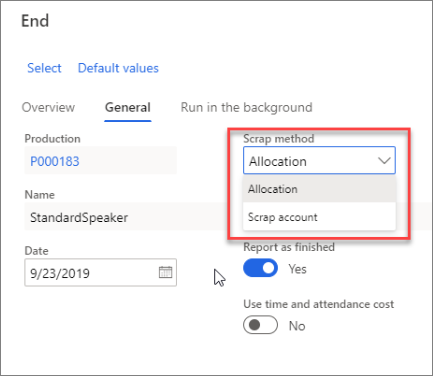End production orders
Before ending production, Supply Chain Management calculates the actual costs for the quantity produced. The system reverses all estimated costs of material, labor, and overhead and replaces them with actual costs. These costs are based on realized material and time consumption.
You can compare actual costs to estimated material and time consumption costs that the system calculated when it estimated the production order. Final price calculation covers the consumption of items, services, item gains, and operations.
When you end production orders, the system cost-accounts them. Next, the system generates a receipt transaction with the Purchased status for the production item. This transaction covers receipts for items that were created and have the status Ordered, items that were reported-as-finished and have the status Received, and receipt transactions that were generated earlier are deleted. The system automatically reverses previously posted items and WIP in the ledger and then posts and closes all journals.
If you select the End job checkbox when you run the cost calculation, the production order status changes to Ended. This status prevents the system from inadvertently posting other costs to a completed production order.
Final price calculation
Final price calculation covers the following scenarios:
Consumption of items - The cost amount for item consumption is calculated as:
Component item consumption * Item's cost price = Realized cost amountIf the consumed items aren't marked as open-transaction, the system uses average cost and takes the item's cost price from inventory. However, if the item is marked as open-transaction for a receipt transaction with the Purchased status, the system takes the item's cost price from that receipt transaction. For costing of the item consumption, the system issues a transaction with the Sold status and then deletes the original issue transaction with the On order or Picked status.
When the production order comes to the costing, the system handles all products with type Item or Service in the BOM the same way.
Finished items - The cost amount for finished items is calculated as:
Number of finished items * Item's cost price = Realized cost amountThe system takes the item's cost price from the item when you calculate costing. During the costing of item gains, the system updates the original inventory transaction to the Purchased status from Ordered or Received.
Consumption of operations
Operation consumption includes run times, setup time, and processed quantity. The cost amount for the consumption of run time, setup time, and processed quantity is calculated as follows:
(Reported time consumption * Reported hourly cost price) + (Reported processed quantity * Reported quantity cost price) = Realized cost amount
When you select automatic picking of resources, the system retrieves the cost price automatically from the run time category, setup category, and processed quantity category that are stated on the route.
If you report the number of finished items for the operations by using the Report as finished journal, the system uses these items in costing.
End page
Use the End page to finish production orders and assign them the status of Ended. After you report the orders as ended, you can't update them or revert them to an earlier status.
The main fields on the End page are:
Production - Enter the production order number that you want to end. You can enter any existing production order number and use the Select button to filter for a production order number. If you access the page from the Production orders page, the field is automatically filled in with the selected production order.
Date - Specify the date to post the production. The system date is the default.
Report as finished - Select this field to report the production order as finished before you end it.
Scrap method - Specify how to post item and resource consumption for scrap quantity. If the stated quantity is larger than the quantity reported as finished, scrap is present.
Go to Production control > Production orders > All production orders. Find an order with the status of Reported as finished, select the Production order tab, and then select Process group > End.
Scrap is calculated as: (Quantity started - Quantity reported as finished) / (Quantity > started) * 100
The options that you can select from the Scrap method dropdown menu are:
Scrap account - The system posts the calculated scrap in the ledger account to the scrap account specified in the Scrap account field.
Allocation - The system allocates the calculated scrap as an added cost to the quantity of finished items that are reported as finished.
When the production order has a status of Ended, you can't update it. The system cost accounts the production order and generates a receipt transaction with the Purchased status for the produced item. Then, the system closes all journals that are associated with the production order.
Analyze variances for a completed production order
The system calculates production variances after you end a production order for a standard cost item. The variances reflect a comparison between the reported production activities and the standard cost calculation for the production item.
The variances don't provide a comparison to the production order's estimated costs. The reported production activities include consumption of material and routing operations, associated indirect costs, and the reported-as-finished quantity.
The system calculates the following types of variances:
Lot size
Production quantity
Production price
Production substitution
The detailed variance information provides one tool to help users understand the source of each variance. To anticipate variances prior to ending a production order, you should analyze the detailed information that the Cost estimates and costings report provides.
For more information, see Common sources of production variances.
